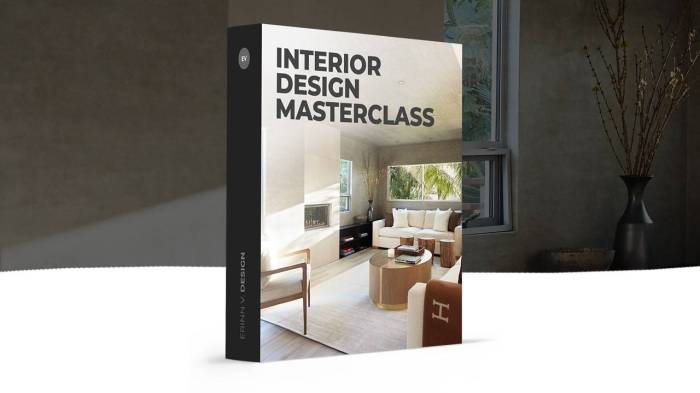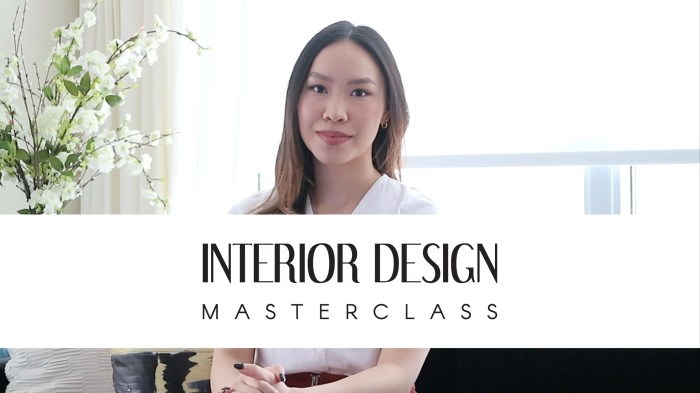Mastering the Art: A Comprehensive Guide to Masterclass Interior Design
Embark on a journey into the world of masterclass interior design, where creativity meets functionality in perfect harmony. This introduction sets the stage for an enlightening exploration of the principles, techniques, and trends that define this captivating domain.
Discover the essence of interior design and how mastering its fundamentals can transform spaces into works of art.
Introduction to Masterclass Interior Design

A masterclass in interior design is an in-depth, advanced course that focuses on honing your skills and knowledge in the field of interior design. It goes beyond the basics and delves into complex design principles, techniques, and strategies.
Mastering interior design principles is crucial for anyone looking to excel in the industry. It allows you to create spaces that are not only aesthetically pleasing but also functional, practical, and tailored to the needs of the clients.
The Benefits of Taking a Masterclass in Interior Design
- Enhanced Skillset: Masterclasses provide you with advanced techniques and knowledge that can take your design skills to the next level.
- Networking Opportunities: Connecting with industry professionals and like-minded individuals can open up new doors and collaborations.
- Increased Confidence: Mastering interior design principles will boost your confidence in tackling complex design projects.
- Career Advancement: Having a mastery of interior design can lead to better job opportunities and increased demand for your services.
Key Concepts in Interior Design
Understanding the fundamental elements of interior design is essential in creating functional and aesthetically pleasing spaces.
Role of Color Schemes
Color schemes play a crucial role in interior design as they set the overall mood and atmosphere of a space. Different colors evoke different emotions and can impact the perception of size and brightness within a room.
- Complementary colors create a dynamic and vibrant feel.
- Analogous colors provide a harmonious and calming effect.
- Monochromatic color schemes offer a sophisticated and cohesive look.
Significance of Lighting
Lighting is a key element in interior design that can greatly influence the ambiance of a space. Proper lighting enhances the functionality of a room and highlights its design features.
- Natural light creates a sense of openness and warmth.
- Task lighting is essential for performing specific activities efficiently.
- Ambient lighting sets the overall mood and tone of a space.
Impact of Furniture Layout
The layout of furniture in a room affects its functionality and flow. Proper furniture arrangement can optimize space usage, improve traffic flow, and create a balanced and harmonious environment.
- Consider the scale and proportion of furniture pieces in relation to the room size.
- Create designated areas for different activities to enhance usability.
- Balance the placement of furniture to ensure visual harmony and comfort.
Design Principles and Techniques
In interior design, understanding various design principles and techniques is crucial to creating visually appealing and functional spaces. Let's explore some key concepts in this area.
Exploring Different Design Styles
- Modern: Characterized by clean lines, minimalism, and a focus on simplicity.
- Minimalist: Emphasizes simplicity, functionality, and a neutral color palette.
- Eclectic: Combines elements from different styles to create a unique and personalized space.
Creating a Cohesive Design Concept
- Start with a central theme or color scheme to tie the space together.
- Use consistent materials, textures, and patterns throughout the room for harmony.
- Consider the flow and layout of the space to ensure a cohesive design concept.
Tips for Balancing Aesthetics and Functionality
- Choose furniture and decor that not only look good but also serve a practical purpose.
- Optimize the use of space by incorporating storage solutions and multifunctional furniture.
- Ensure good lighting to enhance the aesthetics of the space while also being functional.
Enhancing Spaces with Textures and Patterns
- Experiment with different textures like wood, metal, fabric, and glass to add visual interest.
- Use patterns strategically to create depth and dimension in a room.
- Consider the scale and placement of textures and patterns to avoid overwhelming the space.
Hands-On Projects and Exercises
Putting interior design concepts into practice through hands-on projects and exercises is a great way to enhance your skills and creativity. Here are some practical suggestions and step-by-step guides to help you get started:
Creating Mood Boards
Before starting any interior design project, creating a mood board can help you visualize the overall look and feel you want to achieve
- Gather inspiration from magazines, online sources, and your surroundings.
- Select a color palette, textures, patterns, and images that resonate with your design vision.
- Arrange your chosen elements on a board or digitally using apps like Canva or Pinterest.
- Review and adjust until you are satisfied with the cohesive look of your mood board.
Designing Floor Plans
Understanding how to create functional and aesthetically pleasing layouts is essential in interior design. Follow these steps to design a floor plan for a room:
- Measure the dimensions of the room and note any architectural features or obstacles.
- Decide on the focal point and purpose of the room (e.g., living room, bedroom, kitchen).
- Sketch different furniture arrangements to optimize space and flow.
- Use online tools like Floorplanner or SketchUp to create a digital floor plan with accurate measurements.
Room Makeover Project
Transforming a room through a makeover project allows you to apply design principles in a practical setting. Here are some steps to conduct a successful room makeover:
- Declutter and assess the current layout and decor of the room.
- Set a budget and prioritize areas for improvement (e.g., lighting, furniture, color scheme).
- Research and source new decor elements that align with your design goals.
- Execute the makeover, focusing on proper placement and balance of elements to achieve a cohesive look.
Selecting and Arranging Decor Elements
The selection and arrangement of decor elements can significantly impact the overall aesthetics of a space. Consider these tips when choosing and arranging decor items:
- Stick to a cohesive color palette to create a harmonious look.
- Mix textures and patterns for visual interest and depth.
- Use the rule of threes to create balanced groupings of decor items.
- Experiment with different layouts and placements to find the most visually appealing arrangement.
Industry Insights and Trends

In the world of interior design, staying up-to-date with the latest trends and insights is crucial to creating innovative and appealing spaces. Let's explore some of the current industry insights and trends shaping the field.
Current Trends in Interior Design
- Minimalism: Clean lines, clutter-free spaces, and a focus on functionality are key elements of the minimalist trend.
- Biophilic Design: Incorporating natural elements like plants and greenery to promote well-being and connection to nature.
- Bold Colors and Patterns: Experimenting with vibrant hues and eye-catching patterns to add personality to spaces.
- Mixing Old and New: Blending vintage pieces with modern elements for a unique and eclectic look.
Insights from Renowned Interior Designers
"Design is a journey of discovery, innovation, and storytelling."
Kelly Wearstler
Renowned interior designers like Kelly Wearstler often emphasize the importance of creativity, individuality, and pushing boundaries in design.
Sustainable and Eco-Friendly Design Practices
- Using recycled materials and sustainable resources to reduce environmental impact.
- Incorporating energy-efficient lighting and appliances to promote sustainability.
- Optimizing space planning and layout to maximize natural light and ventilation.
Emerging Technologies Impacting Interior Design
- Virtual Reality (VR) and Augmented Reality (AR) for immersive design visualization.
- Smart Home Technology: Integration of automation and control systems for enhanced comfort and convenience.
- 3D Printing: Customized furniture and decor pieces created with innovative technology.
End of Discussion
As we conclude our discussion on masterclass interior design, we reflect on the myriad possibilities and inspirations it offers to aspiring designers and enthusiasts alike. Dive deep into this realm of creativity and innovation, and unleash your imagination to redefine the spaces around you.
Essential Questionnaire
What makes a masterclass in interior design unique?
A masterclass in interior design goes beyond basic principles, delving into advanced techniques and industry insights to elevate your design skills to a professional level.
How can I balance aesthetics and functionality in my design?
Striking a balance between aesthetics and functionality involves thoughtful planning, incorporating elements that are visually appealing while also serving a practical purpose.
What are some current trends in interior design?
Current trends in interior design include sustainable practices, minimalist styles, and the integration of technology for smart living spaces.